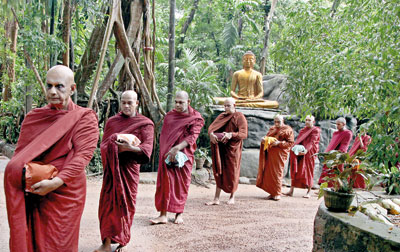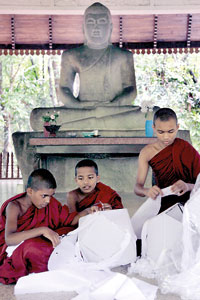Under the shade of trees, they put words into action
View(s):Tree by tree, this was the beginning of the Gothama Thapowanaya on the outskirts of Colombo in the ’60s. Here Ven. T. Mithabani Maha Thera, speaks to Kumudini Hettiarachchi of this haven for both monks and lay people
Absolute stillness disturbed only by the gentle rustle of rain sliding down from a heavy canopy and the muted call of a few birds.
Suddenly, along a gravel track framed by thick foliage, emerge a long line of barefoot, brown-robed monks, varying in age, from the very young to the elderly. As they wend their way with measured tread from their meditation kuti, with their alms-bowls and yellow and brown umbrellas to ward off the rain, there is an aura of peace and tranquillity.

Monks wend their way with their alms bowls. Pix by M.A. Pushpa Kumara
The humble devotees gathered at 11 in the morning, themselves braving the heavy showers, make ready to serve the monks their daane. Like the monks who are leading simple lives in meditation or the samaneras who are being guided in the footsteps of Lord Buddha, the meal too is sparse – red rice, mallun, a potato curry and a bitter-gourd curry. Total strangers, we may be, but the devotees spontaneously include us not only in the serving but also the offering of alms.
We are at the Gothama Thapowanaya, not some place off the beaten track, but right in the midst of Rajagiriya, off the Buthgamuwa Road at Kalapaluwawa.
Here is where, back in September 1962, Ven Kudawelle Wangeesha Maha Nayake who had lived in town areas, after having undergone meditation guidance under the Burmese monk, Maha Si Shado, decided to find a “hudakala sthanayak”(a lonely location), explains Ven. T. Mithabani Maha Thera, adding that he then set up the Mathika Mathru Samithiya to secure such a place. The beginnings were humble, with 10 bhavana kuti, a bana salawa and a daana salawa at Thapowanaya. Working closely with Ven. Dodampahala Chandasiri Maha Nayake who is currently the President of the Samastha Amarapura Nikaya, he had set about this task.
Then they went around the country and their dedication and hard work ensured the establishment of the Kalu Diya Pokuna Thapowanaya at Mihintale, the Mahanuwara Sri Dalada Thapowanaya, the Kegalle Abhayabhoomi Thapowanaya, the Padaviya Deviyange Thapowanaya and the Kataragama Buddha Sravaka-Sravika Meditation Centre, he points out.
Although the Loku Hamuduruwo is no more since 1982, the two most important lessons of “karunawa and pragnawa” that he taught his golayas live on, says Ven. Mithabani.
Ven. Mithabani himself came under the influence of the Loku Hamuduruwo in the 1960s as a little boy of seven. For him as a child, life was very comfortable. His father owned a lot of land in Minuwangoda and there was plenty of food on the table for him and his siblings and many new clothes whenever they wanted. The blow came suddenly, when his father fell off a jak tree and became paralysed from the waist down and his mother gradually sold most of the land, in desperate attempts to get his father back on his feet.
When she was about to sell the last plot of land on which their home was, his father urged her not to do so. However, by that time hard times had descended on the family, particularly Ven. Mithabani and his younger sister.
Many a day there was nothing to eat and he had only one pair of shorts and a shirt to wear to school, he says, reliving those difficult years. No shoes, not even a pair of rubber slippers did he and his sister have and walking the long distance to school was painful because the tarred road would scorch their soles. “My sister would refuse to walk and I would apply mud on my feet from the fields we had to cross and carry her to school,” he says, adding that cutting remarks and mocking would be their lot at school. The one and only uniform had to be washed and dried on the dum messa. The teacher would throw his writing book out of the classroom’s half-wall, because the lessons of all subjects he would write on a single exercise book.

Young samaneras: It’s time to make kudus for Vesak
Oft times, they just could not go to school and while his mother went looking for work as a labourer or servant, he would watch a person go across the fields early morning and return at night with a lit hurricane lantern.
He looked so contented that the little boy was drawn to him, not realising that it was a monk who was managing two temples. He just wanted to be like him, but his mother was not too pleased as he was only about six years old. However one day when his mother went to the cooperative, she met a friend who told her that a senior monk would like to help anyone interested in joining the Sasana, along that path. A telegram followed from the Loku Hamuduruwo and in 1963, Ven. Mithabani came under the tutelage of the Loku Hamuduruwo. “For about two to three weeks, I cried gripped by loneliness. There was fear too for as night descended the cicadas would begin their chirping,” he says.
The Loku Hamuduruwo personified gentleness in the right spirit of Buddhism – whenever the abiththiyo stepped out of line, it was not the cane that was brandished. “The punishment would be to plant a tree,” smiles Ven. Mithabani, who along with the others would sit at his feet and listen to his words of wisdom. This is how the man-made forest of Thapowanaya slowly but surely took root……..rath hadun, hadun, aralu, bulu, even karabu neti, pihimbiya, mahogany and kohomba now adorn the 12 acres, whereas earlier it was a rubber estate.
Under its mantle lies in addition to facilities for people who wish to get away from the madding crowds and engage in meditation, a centre of learning for both bhikkus and lay youth and the Kumara Kasyapa Boys’ Home and Vocational Training Centre for orphans. This centre is very close to the heart of Ven Mithabani, for he knows what it is to be poor. The boys in the home do not lack anything.
For those white-clad men, women and children who will gather to listen to bana at the Gothama Thapowanaya on the thrice-blessed day of Vesak, the take home message is not only the words of Lord Buddha but also the example of the monks who turn these words into action.
84,000 lamps for Vesak
As Sri Lanka celebrates Vesak, when Lord Buddha was born, attained Enlightenment and passed away Ven. Mithabani is mobilising devotees to offer 84,000 lamps in July linked to this important religious festival.
The lamps are to be lit at Maligawila, where two serene statues – those of the Gautama Buddha and the Maithri Buddha had been built in the 7th century.
Follow @timesonlinelk
comments powered by Disqus


